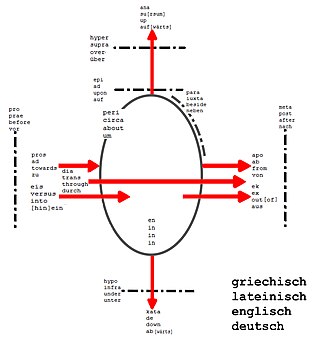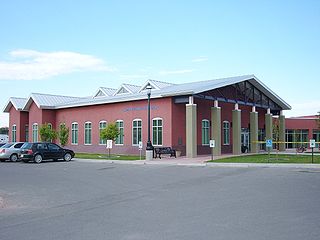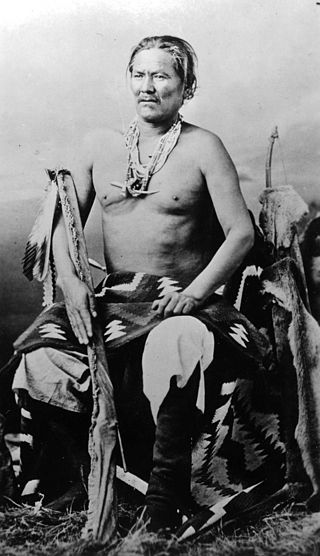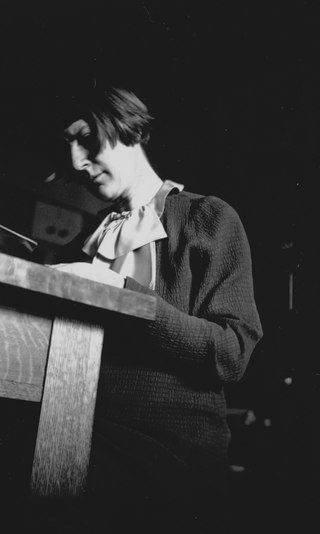Related Research Articles

A prefix is an affix which is placed before the stem of a word. Particularly in the study of languages, a prefix is also called a preformative, because it alters the form of the word to which it is affixed.

Aztec is a city in, and the county seat of, San Juan County, New Mexico, United States. The city population was 6,126 as of the 2022 population estimate. The Aztec Ruins National Monument is located in Aztec.

Navajo or Navaho is a Southern Athabaskan language of the Na-Dené family, through which it is related to languages spoken across the western areas of North America. Navajo is spoken primarily in the Southwestern United States, especially in the Navajo Nation. It is one of the most widely spoken Native American languages and is the most widely spoken north of the Mexico–United States border, with almost 170,000 Americans speaking Navajo at home as of 2011.
In sociolinguistics, a variety, also known as a lect or an isolect, is a specific form of a language or language cluster. This may include languages, dialects, registers, styles, or other forms of language, as well as a standard variety. The use of the word variety to refer to the different forms avoids the use of the term language, which many people associate only with the standard language, and the term dialect, which is often associated with non-standard language forms thought of as less prestigious or "proper" than the standard. Linguists speak of both standard and non-standard (vernacular) varieties as equally complex, valid, and full-fledged forms of language. Lect avoids the problem in ambiguous cases of deciding whether two varieties are distinct languages or dialects of a single language.
Robert W. Young, professor emeritus of linguistics at the University of New Mexico, was an American linguist known for his work on the Navajo language. From the late 1930s, Young cooperated with the Navajo linguist and scholar William Morgan, publishing a "practical orthography" in 1937.
The East Papuan languages is a defunct proposal for a family of Papuan languages spoken on the islands to the east of New Guinea, including New Britain, New Ireland, Bougainville, Solomon Islands, and the Santa Cruz Islands. There is no evidence that these languages are related to each other, and the Santa Cruz languages are no longer recognized as Papuan.

Zuni is a language of the Zuni people, indigenous to western New Mexico and eastern Arizona in the United States. It is spoken by around 9,500 people, especially in the vicinity of Zuni Pueblo, New Mexico, and much smaller numbers in parts of Arizona.

Kenneth Locke Hale, also known as Ken Hale, was an American linguist at the Massachusetts Institute of Technology who studied a huge variety of previously unstudied and often endangered languages—especially indigenous languages of North America and Australia. Languages investigated by Hale include Navajo, O'odham, Warlpiri, and Ulwa.

The Navajo are a Native American people of the Southwestern United States.
Asdzą́ą́ Nádleehé, meaning "the woman who changes", is one of the creation spirits of the Navajo. According to the Navajos, she created the Navajo people by taking old skin from her body and using her mountain soil bundle to create four couples, who are the ancestors of the four original Navajo clans. She helped create the sky and the earth. She is the mother of twins Monster Slayer and Born for Water.
Obligatory possession is a linguistic phenomenon that is common in languages whose nouns are inflected for possessor, and some words, commonly kinship terms and body parts, cannot occur without a possessor in those languages. The World Atlas of Language Structures (WALS) lists 43 languages in its 244 language sample as having obligatory possession. Languages with obligatory possession are concentrated in New Guinea and in North and South America. Generally, obligatory possession is found throughout a family, but not all Athabaskan languages have it. Slavey does not have obligatory possession but Navajo has it. Obligatory possession is also present in the language isolate Haida. English has it for own as an adjective: one's own body not *an own body.
Faye Elva Edgerton was a missionary, linguist and Bible translator with Wycliffe Bible Translators. She translated the New Testament into the Navajo and Apache languages, as well as helping some with the Hopi and the Inupiat/Eskimo New Testaments.
This article is about the sound system of the Navajo language. The phonology of Navajo is intimately connected to its morphology. For example, the entire range of contrastive consonants is found only at the beginning of word stems. In stem-final position and in prefixes, the number of contrasts is drastically reduced. Similarly, vowel contrasts found outside of the stem are significantly neutralized. For details about the morphology of Navajo, see Navajo grammar.
Tó Neinilii is the rain god of the Navajo people of Arizona and New Mexico. In tribal stories, he is a trickster figure. In the tribal dances he is represented by a masked man who enacts the part of a clown. He is shown carrying a water pot. In myths, he is the fool who dances about in order to show that he is pleased with what is happening. Tó Neinilii was said to often argue with the Navajo god of gambling, Nohoilpe. In times of drought or misfortune due to the weather, it was often said that Tó Neinilii had lost a bet with Nohoilpe. In tradition, Toneinili saved the first Navajo people from the sea monster Tééhoołtsódii. Some Navajo believe that Tonenili is also in control of snow, sleet, and hail. In modern times it is said that Tonenili is in charge of thunder and lightning, but this does not have traditional evidence.
The Pueblo linguistic area is a Sprachbund consisting of the languages spoken in and near North American Pueblo locations. There are also many shared cultural practices in this area. For example, these cultures share many ceremonial vocabulary terms meant for prayer or song.

Ádahooníłígíí was a Navajo-language monthly newspaper that was published in the Southwestern United States from 1943 to 1957. After the Cherokee Phoenix, operating from 1828 to 1834, it was the second regularly circulating newspaper in the United States that was written in a Native American language. It was the first newspaper to be published in Navajo and the only one to have been written entirely in Navajo. In April 2019, roughly 100 issues of the newspaper were digitized as a part of the University of Arizona Library's National Digital Newspaper Program and they are currently available online.

Southern Athabaskan is a subfamily of Athabaskan languages spoken primarily in the Southwestern United States with two outliers in Oklahoma and Texas. The languages are spoken in the northern Mexican states of Sonora, Chihuahua, Coahuila and to a much lesser degree in Durango and Nuevo León. Those languages are spoken by various groups of Apache and Navajo peoples. Elsewhere, Athabaskan is spoken by many indigenous groups of peoples in Alaska, Canada, Oregon and northern California.

Gladys Amanda Reichard was an American anthropologist and linguist. She is considered one of the most important women to have studied Native American languages and cultures in the first half of the twentieth century. She is best known for her studies of three different Native American languages: Wiyot, Coeur d'Alene and Navajo. Reichard was concerned with understanding language variation, and with connections between linguistic principles and underpinnings of religion, culture and context.

St. Michael's Mission, the first permanent Catholic mission to the Navajo, was established in 1898. A school was opened in 1902.
References
- 1 2 3 4 5 Frisbie, Charlotte J. (2008). "On Two William Morgans in Navajo Studies". New Mexico Historical Review. 83 (4).
- 1 2 3 4 5 6 7 8 9 10 Dinwoodie, David W. (2003). "William Morgan (1917-2001): Navajo Linguist". Anthropological Linguistics. 45 (4): 426–449. JSTOR 30028911 – via JSTOR.
- ↑ "Obituaries for Jan. 28, 2021". Navajo Times. Jan 28, 2001. Retrieved Feb 8, 2024.
- ↑ Peery, Char (April 2012). "New Deal Navajo linguistics: Language ideology and political transformation". Language & Communication. 32 (2): 114–123. doi:10.1016/j.langcom.2011.05.003 – via Elsevier Science Direct.